SHINJUKU
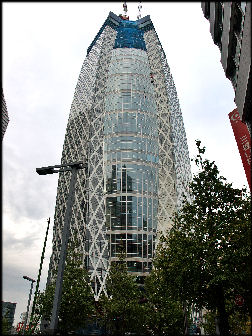
Shinjuku (Shinjuku Station)is a high-rise shopping and entertainment hub. JR Shinjuku Station is an immense terminal, which serves the most passengers of any station in Japan a day. The Tokyo Metropolitan Government office building is one of Tokyo’s main landmarks. It has an observatory on the 45th floor open from 9:30am to 11:00pm (enter by 10:30pm).
Shinjuku is split into three major areas: 1) Shinjuku Street, 2) the Kabukicho district, the main sleaze area, and 3) the area on west side of Shinjuku station. Shinjuku Street (pedestrian-only on Sundays) is a shopping area lined with large department stores, fashionable specialty shops, restaurants and bars. Golden Street was a center the avant garde scene in the 1960s. Now it features dozens of little bars ensconced in spaces formally occupied by brothels. Many of the bars have regular customers who often look a bit shocked when strangers or foreigners come in.
Websites: Shinjuku official site foreigncity.shinjuku.tokyo.jp ; Wikipedia Wikipedia ; Shinjuku Guide shinjuku-guide.com ; Japan Guide japan-guide.com ; Shinjuku Map: Tokyo Pocket Guide tokyopocketguide.com
Shinjuku Station is Japan's largest train station. As may as four million commuters on 19 train lines day pass through it every day. During rush hour special guards are sometimes employed to push passengers onto their trains. In the Edo Period, Shinjuku was where people parked their carts and animals and was known for its large amounts of horse dung. For a splendid view of all the action today check out the Sky Bar in the Park Hyatt Tokyo, which sits on top of the glass-and-chrome Shinjuku Park Tower and is where several scenes from the film “Lost in Translation” were shot. Websites: Wikipedia Wikipedia ; JR Map of Shinjuku Station jreast.co.jp
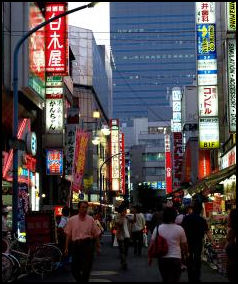
West Side of Shinjuku Station is newly developed business quarter with several new modernist skyscrapers, including Kenzo Tange's Tokyo Metropolitan Government Offices, a three building complex with a 45-floor tower with free panoramic views. Also worth checking out are Shinjuku NS Building, with the world's largest pendulum clock (29 meters), the 110-meter-long interior "sky bridge," and the numerous restaurants on the 29th and 30th floor. Worth a look are the Kio Department store and some of the world's largest camera stores.
Gakuen Cocoon Tower, which stands in front of JR Shinjuku Station’s west entrance, is among the most striking new modernist buildings in Tokyo. Completed in October 2008, its is 203 meters high and resembles the new, spiral cocoon building in London. Gakuen Cocoon Tower was designed by Tange associates, which is run bu Noritake Tange, the oldest son Kenzo Tange.
Shinjuku Gyeon Park (5 minute walk from Shinjuku-Gyeon subway station) features Japanese- and Western-style gardens and has been described by some as having the most gardens in Tokyo. Covering 144 acres, it also has good public recreation facilities and is known for its irises, which bloom in May and chrysanthemum shows in November. The park is open from 9:00am to 4:00pm.
Kabukicho: Tokyo's Sex District
Kabuki-cho (part of Shinjuku) is regarded as Tokyo's largest entertainment district and is the center of Tokyo’s sex industry. Lining its main streets and side streets are sex clubs, hostess bars, image rooms, bunny-suit clad streetwalkers, strip clubs, gambling parlors, peep shows, "soaplands" parlors, and bars with nude waitresses. Beer vending machines are found at every intersection.
Kabukicho was the center of Tokyo street life and culture in the 1960s and 70s, when it attracted drag queen geishas, rockabilly rent boys, prostitutes and yakuza gangesters. Back at that time prostitution was legal and controlled.
Kabuki-cho is home of several yakuza headquarters. The yakuza has traditionally controlled districts pornography shops, gambling parlors, and prostitution rings. Like their Italian counterparts, they also hustle "protection" money from local businesses as well as major corporations.
Many of the prostitutes and sex workers in Kabuki-cho today are Chinese who work for Chinese gangs rather the yakuza. Many of the businesses are also run by Chinese. Supermarkets sell Shanghai newspapers and restaurants offers noodles dishes found in Canton.
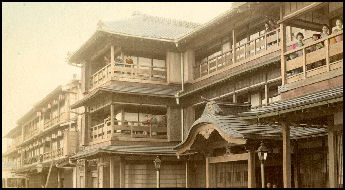
Yoshiwara in the 19th century Despite its unsavory reputation Kabuki-cho is generally safe to stroll around at night and certainly more safe than similar districts in cities like Bangkok or Manila. Places that do attract trouble generally don’t allow foreigners on the premises. Websites: Wikipedia Wikipedia ; Guardian article Guardian
Yoshiwara (near Minaimi-Senju Station) is Tokyo's oldest red light district. Founded in 1657, it now contains Japan's largest concentration of "soaplands,” Japanese-style brothels, some which have amusing nicknames and are decorated like French chateaux. Many of the 18th and 19th century woodblock prints of women in kimonos and yukatas were set in brothels in Yoshiwara. Nearby is Sanya, sort of Tokyo’s version of skid row. A number of homeless people make their home here. The food street on the railway line to Shinjuku is known locally as “Piss Alley.”
Shin-Okubo: Tokyo’s Koreatown
Shin-Okubo:(near JR Okubo Station, north of Shinjuku) is Tokyo’s Korean pop culture mecca. Kirsty Bouwers wrote in Time Out: “Better known as Koreatown..it’s the latest hotspot for teenage girls who have taken to the Korean pop culture craze, with more Hangul (Korean alphabet) signs than you can shake a stick at. Trying to walk down the main road on a weekend is not for the faint of heart. Yet it’s not only an enclave for the K-obsessed – quite a few different ethnic minorities have taken to the area for its cheap rents, ease of transportation and hodgepodge of cultures. If you don’t live in the area, the best way to get to know it is through its cafés and restaurants. There’s food here, and lots of it. Come hungry, leave delightedly full. [Source: Kirsty Bouwers, Time Out, October 11 2018]
“Snacking and shopping your way down the main thoroughfare is the way to go, with the offerings always changing depending on what’s hot with the young crowd. Some staples are always in fashion, though: have a hotteok (pancake filled with anything from nuts to cheese and honey) at Popo Hotteok, treat yourself to bingsu (Korean-style shaved ice) at Homibing or Cafe de Bingsu (pictured above), or check out tteokbokki (hot and spicy Korean rice cakes) at the foodcourt inside Seoul Ichiba. In between mouthfuls, marvel at the latest cosmetics at the ginormous Skin Garden, The Beauty Shop or Re:Make, just a handful of the skincare and cosmetics shops in the area. Take a peek at the latest Korean idol heartthrob at Hanryu Plaza. For a coffee break, stop by Egg Coffee for a Vietnamese hot drink of the same name.
“Spend some time soaking up at jimjilbang (Korean bathhouse) Ruby Palace (sorry men, it’s for women only), or the public baths of Mannenyu. If you want a crash course in K-pop and J-pop, up-and-coming idols perform at Showbox, while Earthdom is possibly the key venue for Tokyo’s punk and hardcore fans. Some comedy shows and other live performances are held at the nearby Globe Theatre. For booze, you’re probably best off at some of the many restaurants, but drinks without food are to be had at Vivo Daily Stand and Maccoli Bar. Art Space Bar Buena has regular artsy events, or otherwise just head over to Shinjuku to see where the night takes you.”

Skyscrapers of Shinjuku
SHIBUYA
Shibuya (Shibuya Station) is one of Tokyo's most happening places. Known for its rowdy nightspots, noodle restaurants, shopping arcades, flashing lights, huge display screens, department stores, boutiques, hostess bars, and smokey clubs, it is a place where executives and salary men gather to drink heavily, young people hang out, tourists experience Tokyo’s intensity, women shop and huge crowds cross the streets.
Shibuya is a fast-growing modern shopping and entertainment area, with department stores, shops, restaurants and bars, around Shibuya station. The landscape of colored-light billboards, cramped buildings filled with pachinko parlors, karaokes, shops, and bars on different floors was a model for the film “Blade Runner” . The district is particularly popular with younger people. Every street and area in the district it seems has a different atmosphere. The Shibuya Center Street is crowded with a multitude of shops, including youth fashion shops, fast food restaurants and game centers, and it is famous as the place where new trends are born that quickly spread among the youth nationwide. Koen-dori Street, which extends to Yoyogi Park, is a shopping street with a row of department stores and fashionable buildings that attract families in particular. This is a trendsetting place for youth culture.
Shibuya also serves as a starting point for Meiji Shrine, Yoyogi Olympic Park, Harajuku, Akasaka and Roppongi. Harajuku and Shibuya districts are where young Japanese come to be seen and check out the latest fashions and trends. The main square is the home of one of the world's busiest pedestrian crosswalks. All around are liquid crystal display screens showing off the latest Japanese products, fashions and pop stars. Shibuya station sees about 700,000 people a day
Websites: Shibuya City city.shibuya.tokyo ; Wikitravel Wikitravel ; Japan Guide japan-guide.com Shibuya Map: Tokyo Essentials tokyoessentials.com/shibuya-map
Shibuya and Youth Culture in Japan
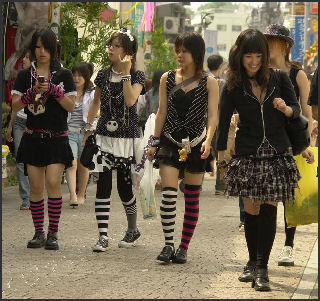
girls in Shibuya in the 1990s Shibuya has become a primary place for young people, particularly girls, to hang out into the wee hours of the morning. The shops in and around 109, a shopping center near the main crossroads, is where young girls in the latest street fashions and outrageous make-up gather. On 109, Alexander Harvey wrote in the Atlantic Monthly, “Saleswomen in ruffled miniskirts shout their welcome in sticky-sweet tones above the din of club music. Japanese girls with clouds of strawberry blond curls and heavy fake eyelashes cruise the mall’s 10 floors, shopping bags dangling from their wrists.” The mall “has everything a girl could want — terry cloth hot pants, argyle sweater dresses, rhinestone-studded skull rings — all at deep discounts to department store prices.”
Many people also gather around Manderake, the world’s largest manga and anime department store. Trends that begin here spread across Japan and often make their way to Hong Kong, Seoul, Taipei and Shanghai and even London and New York. Sometimes you can see marketing agents with clipboards asking young girls what they think about this or that.
Shibuya has been center of youth culture and street fashion since the 1970s when college-age women began gathering here to shop for the latest fashions. Over the years the girls that have come have been getting steadily younger. In the 1980s high school girls began dominating. By the 1990s, middle school girls were appearing in larger and larger numbers. Now days there are even large numbers of elementary school girls. Shibuya also has traditionally been a place where men met with geishas or their lovers. This mix of men and young girls that sometimes takes place here produces sleaze and trouble.
Shibuya has become a primary place for young people, particularly girls, to hang out into the wee hours of the morning. One 16-year-old Shibuya girl told the Daily Yomiuri, “I often spend the night in the streets or at karaoke shops, or I stay with men who ask me for a date. I’ve not returned home for several days now, because everything is boring at home, where I have nothing to do.”
Particularly disturbing is the number of young girls seen at night talking with unsavory looking middle-age men. The men will strike up a conversation, and ask the girls if they want something to eat. When the girl above was asked if she engaged in “compensated dating: (a euphemism for teenage prostitution), she said, “Why not? I can earn ¥60,000 a date. There are also large numbers of male “scouts” in their 20s who try to lure young girls into some endeavor, usually bad. One Shibuya regular told the New York Times, “Every scout is trying to get a girl into his business. There’s the store scout, the restaurant scout, the sex business scout, the entertainment industry scout, the fashion magazine scout.”
Hachiko Dog Statue
 Hachiko Dog Statue (in front of Shibuya Station) is universally recognized landmark and arguably Tokyo’s most popular meeting spot. Hachiko is Japan's best-loved animal. A white Akita dog that died in 1935 and is now stuffed and displayed at Japan's National Museum, "”Chu-ken Hachiko” , or "faithful dog Hachiko," was the pet of a Tokyo University professor. Every morning the professor and Hachiko walked together to Shibuya station, where the professor would take the train to work and each afternoon when the professor came home his dog was there waiting for him at the platform.
Hachiko Dog Statue (in front of Shibuya Station) is universally recognized landmark and arguably Tokyo’s most popular meeting spot. Hachiko is Japan's best-loved animal. A white Akita dog that died in 1935 and is now stuffed and displayed at Japan's National Museum, "”Chu-ken Hachiko” , or "faithful dog Hachiko," was the pet of a Tokyo University professor. Every morning the professor and Hachiko walked together to Shibuya station, where the professor would take the train to work and each afternoon when the professor came home his dog was there waiting for him at the platform.
Then, one day in 1925, the professor suddenly died at work. Hachiko waited at the station that afternoon but her master didn't return. She waited again the next afternoon, and the next and the next — through rain, snow and the occasional earthquake — every afternoon for the next nine years. Hachiko's devotion caught the imagination of Japan and the world. In 1934, a year before she died, a statue of faithful Hachiko was erected in Shibuya Station by the Los Angeles Friends of Animals.
The 162-centimeter statue, resting on a 180-centimeter stone base, was made by the celebrated sculptor Teru Ando. In World War II the statue was melted down during scrap metal drive and used to weapons. Later it was replaced. The current statue was made by Ando’s son Takeshi Ando. Made of bronze, it is 91 centimeters tall and sits on a 127-centimeters stone base. It popularity as a meeting has a lot to do with it nearness to one of the world’s busiest train stations
There are hundreds of different Hachiko books and souvenirs. Recently her story was made into a popular Hollywood film, starring Richard Gere. Hachiko merchandise such paw-print tea towels and stuffed toys are available at a Hachiko-themed. souvenir shop near Shibuya Station. Tourists and friends like to pose in front of the statue for photographs. Website: Wikipedia Wikipedia
Theaters in Shibuya and Shinjuku
There are numerous theaters in the Shibuya and Shinjuku Area and it seem like a bunch of them opened in the late 2000s and early 2010s.Hideki Sukenari wrote in the Yomiuri Shimbun: “ Shibuya and Shinjuku are both synonymous with entertainment in Tokyo, but the two districts are undergoing major transformations, with huge theaters and cinema complexes set to revolutionize the city landscape...”In Shinjuku, a mega-cinema complex housed in the new Shinjuku Toho Building opened in 2015. [Source: Hideki Sukenari, Yomiuri Shimbun, December 2, 2011]
”Shibuya is already famous for its theaters and live houses, including Orchard Hall, Theatre Cocoon, Parco Theater, Aoyama Theatre, O-EAST, AX and Club Quattro. But there has been a recent spurt in building new entertainment venues and the area seems to be even more crowded with such facilities. Two cinema complexes — Shinjuku Wald 9 and Shinjuku Piccadilly — opened in 2009.
”In the Prime building, adjacent to Shibuya’s 109 fashion complex, two cinemas have recently been turned into live concert spaces. The first is CBGK Shibugeki, a 242-seat theater operated by entertainment agency Cube Inc. that opened in September. The agency hopes the theater will take on the role of the now-defunct Shibuya Jan-jan, a small theater where such entertainers as Akihiro Miwa and the late Noriko Awaya once staged live performances that are now regarded as legendary. "CBGK Shibugeki is a space where out-of-the-ordinary performances can flourish," said actor Arata Furuta, who is an adviser to the theater.
”Another theater in the Prime building has been transformed into the Mt. Rainier Hall Shibuya live house. The basement of Cinema Rise, which played an important role in Shibuya’s mini-theater boom, was also renovated into the WWW live house.Meanwhile, at the south exit of Shibuya Station, the Shibuya Ward government opened Shibuya Cultural Center Owada, a complex that is home to two halls: Sakura Hall with 729 seats, and Densho Hall with 339 seats.
”Some people feared Shinjuku would lose its prestige as an entertainment hub when local facilities closed one after another — Shinjuku Koma Theater at the end of 2008, Theatre Apple in 2009 and Koseinenkin Kaikan hall in 2010. In the nerve center of Kabukicho, where Shinjuku Koma Theater once stood, land remained vacant for some time, hardly a magnet for visitors who wanted to let their hair down. But in July, Toho Co. announced plans to build the 31-story Shinjuku Toho Building housing a cinema complex and the 1,030-room Washington Hotel on the site. The building is scheduled to open in the spring of 2015. The cinemas will boast 12 screens and 2,500 seats, making it the second-largest cinema complex in Tokyo after Odaiba Cinema Mediage in Minato Ward.
Comedy and Broadway Shows in Shibuya and Shinjuku
Hideki Sukenari wrote in the Yomiuri Shimbun: “The 2,000-seat Tokyu Theatre Orb opened in Shibuya in 2012.” It “has been dubbed a musical theater floating in the air, forms the nucleus of Shibuya Hikarie, a high-rise building built on the site of Tokyu Bunka Kaikan hall near the east exit of Shibuya Station. Hikarie has 34 stories above ground and four below and houses commercial facilities, business offices, art galleries and event halls. [Source: Hideki Sukenari, Yomiuri Shimbun, December 2, 2011]
”Tokyu Theatre Orb occupies Hikarie’s 11th to 16th floors. With a basic blue and white color scheme, the theater’s seating sections and stage are arranged to optimize the theater’s acoustics. The performance space is enclosed by a glass-walled atrium, which gives audiences a sweeping view of the city. Tokyu Corp. President Hirofumi Nomoto said, "We want to create a new Shibuya, a city renowned for its entertainment that will attract guests not only from Asia, but also from around the world." Tokyu Theatre Orb has hosted productions of West Side Story and Million Dollar Quartet, a 2010 New York Broadway hit that depicts the behind-the-scenes story of a music session that focuses on four famous singers, including Elvis Presley.
”Shinjuku is also gaining a reputation as a focal point for comedy performances. The area is heavily populated with comedy venues, including the long-established vaudeville theater Shinjuku Suehirotei, Yoshimoto Kogyo’s theater Lumine the Yoshimoto, Studio Alta and Shinjuku Fu. In May 2011, Shochiku Geino opened the 119-seat Shinjuku Kadoza theater at the site of the Theater/Tops complex. The facility aims to cultivate up-and-coming young comedians. "Shinjuku audiences are tough and don't necessarily laugh at comedians' performances. Because of their critical eye, shinjuku is an appropriate place for young comedians to hone their craft and polish their performances," said Ken Fujii, president of Shinjuku Kadoza.
Harajuku
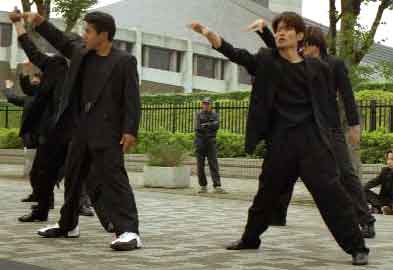
Harajuku dancers Harajuku (one stop from Shibuya on the JR Yamanote line) is a neighborhood popular with fashion-conscious teenagers, who tend to congregate around the record stores and clothes shop. There are also many trendy shops, such as Condomania, restaurants and tea shops in the area. The pedestrian overpass from Harajuku station to Meiji Shrine and the narrow alley of Takeshita Dori is favorite gathering place for young Japanese who like to dress in outrageous cosplay costumes and relish in drawing attention to themselves. Kiddyland is good place to check out the latest weird gadgets.
Harajuku is a collective term for the area that stretches from the Harajuku Station to Omotesando. On the west side of JR Harajuku Station, there is a wood of the Meiji-jingu Shrine that is famous for a Japanese iris field where irises bloom in profusion in the rainy season, June and a treasury that stores the articles Emperor Meiji cherished in the late 19th century. The east side of the station is known nationwide as the young people’s town. On Takeshita-dori Street, in particular, this narrow pedestrian packed with young teenager in weekends.
Harajuku a been known as an center of Japanese fashion since the 1970s and the crossing of Meiji-dor and Omotesandi is regarded as the epicenter. Trends over the years have included “An/Nonozuka” (a “tribe” of young girls with fashion magazines in hand) and “Takenko-zoku” (young people who performed distinctive dances wearing distinctive, colorful clothing. In recent years fast fashion has become the lasting trend with stores like Japan’s Uniqlo, the Gap, Spain’s Zara, Britain’s Tipship/ Topman and Sweden’s H&M have all become firmly planted here.
Harajuku is crowded on the weeks with Goths, Lolitas, Gothic-Lolitas, “visual-kei” glam rockers, flashy boys with strange haircuts, and lest we forgot the Harajuku girls with their funky, girlish hairstyles and their colorful, mismatched, accessory-laden outfits. Takeshita-Dori, across the street from Harajuku Station, is popular with 13 to 15 year olds and is good place to check out the shops that keep Tokyo’s youth culture thriving. The LeForest Department Store, with over 100 trendy boutiques inside, is popular with the younger crowds. Sometimes on a bridge near Harajuku stations teenage girls pose in Gothic make-up, punk clothes and leather kimonos. On Saturday afternoon groups play hip-hop, reggae, punk, ska, hard rock, 50s music and Japanese idol music. Websites: Photos japanforum.com Wikipedia Wikipedia ; Japan Guide japan-guide.com
Akasaka (east of Harajuku) is a night life area with a variety of things to do. There are first-rate Japanese-style restaurants for people that can afford them as well as bars and snack shops, popular with office workers and young people. Akasaka is also the home of fashionable shopping areas like the Shopping Corridor of the Akasaka Tokyu Hotel.
Omotesando
Omotesando (Chiyoda subway line, Omote-sando Station, at the end of Harajuku) is a wide boulevard dubbed the Champs-Élysées of Tokyo. Located in the districts of Shibuya and Minato, it runs from Harajuku to Aoyama and is famous for its designer-label shops and for the buildings of the designer-label shops, many designed by famous architects. It used to be closed off to traffic but now is a busy thoroughfare filling with cars. While its main clientele are older fashionable adults it also has places that attract younger, trendier crowds. There are a large number of cafes, which are fine places to watch the street fashion parade. If you have time check the pet salons that offer aromatherapy and reflexology for dogs.
In Omotesando and its adjacent Aoyama, fashion designers began to set up their offices and studios after the Tokyo Olympics in 1964. Since then, more and more fashion stores for adults, fashionable coffee shops and restaurants have been built in this area. Aoyama with its zelkova tree lined avenue has the atmosphere that resemble those in European streets.
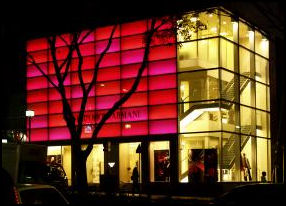
Armani store Prada, Louis Vuitton and Emporio Armani opened new shops here in the early 2000s. The Prada store was designed by Swiss architects Jacques Herzog and Pierre de Meuron, who also designed the Beijing Olympic Bird Nest Stadium and London’s Tate Modern Art Museum. The Prada building is made of glass and features diamond patterns. Other architectural stunners include Ubiqutious One, where Louis Vuitton rules; Tod’s flag ship store, designed to resemble branches of trees; Commes des Garcons, with futurist glass units; and the Ralph Lauren building.
Oriental Bazaar, next to the Dior building, has been a fixture of Omotesando since 1954. It is regarded as Tokyo’s largest and best souvenir and craft store and is a good place to stop to get gift for all the folks back home. Nearby is the flagship store for Kiddyland, one of Japan’s largest toy store chains. Also worth checking out are the green-glass-fronted V28 building near Harajuku station, which is open 24 hours and houses a Zara fashion store and Gold’s Gym; the Audi Forum Ice Cream building, which features an asymmetrical glass facade, with new car models and classic cars displayed in some of the windows; and the UT Store Harajuku, which resembles a neon stock exchange.
Omotesando is popular with parasite singles, young women who live with their parents and have a lot of disposable income. The side streets of Omotesando Avenue in Harajuku, abound with fortunetellers. Some charges as little as ¥500 for five minute palm reading and answers to any question the client asks. Omotesando Hills opened in 2006. Financed by Mori Building and designed by the famous architect Tadao Ando, it cost $330 million and houses 130 stores. There was controversy about its construction as the Bauhaus-inspired Dojunkai Apartments — which had survived the 1923 Tokyo earthquake and the World War II — was torn down to make room for it. To appease critics a small section of the old apartments have been incorporated into the minimalist structure. Websites: Omotesando site omotesandohills.com
Yoyogi Park and Meiji Shrine

a yanqi in Yoyogi Yoyogi Park (Harajuku Station) is 130-acre park with five entrances, a strolling lane and a bicycle route. It used to be where Tokyo's youth gathered on the weekends to hang and party. The parade of young people included punk rockers; "teddy boys" with Elvis Presley haircuts, hip-hop fans practicing their break dancing moves; and Japanese motorcycles gangs, called “bosozokus” ("violently running tribes") revving the engines of their scooters.
Authorities have largely shut down the gatherings. Sometimes young people practice “cos-play” ("costume play") on Sunday afternoons. The parade of characters includes jackbooted Nazis, Kiss look-alikes, white-faced ghosts, Eskimos, vampires, Elizabethan ladies, robot cats and people dressed as a variety of manga and anime characters. . Makeshift Sunday concerts by street rock bands are sometimes held near Harajuku Station.
Meiji Shrine (in Yoyogi Park) is a popular and impressive shrine, dedicated Emperor Meiji, the 19th century ruler who became a symbol for the modernization of Japan. Set in a forested area of Yoyogi Park, it embraces the lovely Inner Garden, famous for its river of irises that bloom in May and a torii gate said to be one of the largest in Japan. It is a serene place surprising close to some of Tokyo most heavily urbanized areas.
Connected to the Inner Garden by a broad cherry-tree lined avenue is the Outer Garden, which contains the Memorial Picture Gallery, various sports facilities including the Yoyogi Sports Center, Komazawa Sports center, the ultra-modern National Indoor Stadium and its shell-shaped annex constructed for 1964 Olympics, and the National Stadium. Nearby is the Tobacco and Salt Museum. Website: Meiji Jingu site meijijingu.or.jp
Image Sources: 1) 7) Visualizing Culture, MIT Education 2) 10) Twin Isles 3) Hector Garcia 4) Wikipedia 5) 6) 9) 11) 13) 14) Ray Kinnane 8) 12) Andrew Gray Photosensibility
Text Sources: JNTO (Japan National Tourist Organization), Japan.org, Japan News, Japan Times, Yomiuri Shimbun, UNESCO, Lonely Planet guides, New York Times, Washington Post, Los Angeles Times, National Geographic, The New Yorker, Bloomberg, Reuters, Associated Press, AFP, Compton's Encyclopedia and various books and other publications.
Updated in July 2020
